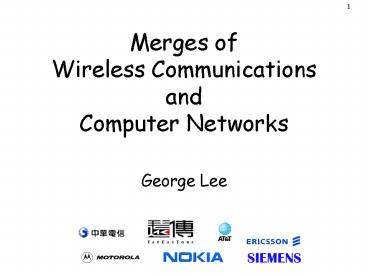Merges of Wireless Communications and Computer Networks - PowerPoint PPT Presentation
1 / 25
Title:
Merges of Wireless Communications and Computer Networks
Description:
Issues in ATM Wireless Network. QoS Voice-Operated Transmission (VOX) ... Crow et. Al, 'IEEE 802.11 Wireless Local Area Networks,' IEEE Communications ... – PowerPoint PPT presentation
Number of Views:69
Avg rating:3.0/5.0
Title: Merges of Wireless Communications and Computer Networks
1
Merges ofWireless CommunicationsandComputer
Networks
- George Lee
2
Abstract (1)
- Merge ATM technology inWireless Communications
Network - ATM Wireless Network(ATM as wireless networks
backbone) - Merge Wireless technology inLAN/ATM networks
- Wireless LAN and Wireless ATM
- WLAN ETSI HIPERLAN (Ad hoc network) IEEE
802.11 (Infrastructure network) - WATM ACTS (Lucent, NEC, Magic WAND) ATM Forum
WATM WG (1999 ?)
3
Abstract (2)
- Issues in ATM Wireless Network
- QoS ? Voice-Operated Transmission
(VOX) Diversity Handoff Layered Cell - Issues in Wireless LAN/ATM
- Frequency allocation, Throughput,
Mobility,Access Methods for Mobile
Interface,Interference and Reliability,
QoS,Mobile TCP/IP, TCP/IP over ATM,
Security,Power Consumption, Human Safety,...
4
Introductions
- Evolution of wireless communications
- Evolution of computer networks
- LAN
- Ethernet, Fast Ethernet, Gigabit Ethernet
- FDDI
- ATM
- WAN
- X.25
- Frame relay
- ATM
5
Evolution of mobile multimedia services
(Nakamura et. Al)
6
- The need for ATM in mobile infrastructure
- Variable bit rate (? different traffic types)
- Voice, FAX, video conference, ...
- Wide range of bit rate (? different traffic
types) - from low bit rate voice and data to high bit rate
video - Asymmetrical communications (? server gt client)
- WWW, VOD,
- Point-to-Multi-point
- VOD
- The need for mobile communicationsin LAN/ATM
- Portability Networking
7
Merges of Wireless Communications and Computer
Networks (3rd gen.)
8
Merges of Wireless Communications and Computer
Networks (4th gen.)
9
References
- H. Nakamura et. al, Applying ATM to Mobile
Infrastructure Networks, IEEE Communications
Magazine, Jan. 1998. - Pahlavan et. al, Wideband Local Access Wireless
LAN and Wireless ATM, IEEE Communications
Magazine, Nov. 1997. - Crow et. Al, IEEE 802.11 Wireless Local Area
Networks, IEEE Communications Magazine, Sep.
1997. - Passas et. al, Quality-of-Service-Oriented
Medium Access Control for Wireless ATM Networks,
IEEE Communications Magazine, Nov. 1997.
10
4 Phases of ATM introduction to mobile networks
1
2A
2B
3
4
Nakamura et. al
11
Requirements of ATM wireless infrastructure
- Power efficiency? Voice-Operated Transmission
(VOX) BS ? MSC? STM ? ATM
Nakamura et. al
12
- QoS? Diversity Handoff MS ? BS ? BSC ? STM ?
ATM
Nakamura et. al
13
- To reduce ATM Packetization delay? Layered cell
Multiplexing in BS ? BSC
Multiplexing
CPSCommon part sublayer
Nakamura et. al
Nakamura et. al
14
Wireless LAN
- 2 types of networks
- Defined in
- Physical layer
- Media Access Control layer
15
(1) Ad hoc network
802.11
16
(2) Infrastructure network
ESS Extended Service Set
802.3, 802.4,802.5, 802.6,or FDDI Backbone
802.11
17
IEEE 802.11
- BSS ESSSTA, AP, Portal (See Figure 1 2)
- 2 types of traffics
- DCF Distributed Coordination Function
- CSMA/CA
- Contention-based ? Ad hoc/Infrastructure
- PCF Point Coordination Function
- AP-controlled polling ? Infrastructure
18
IEEE 802.11 (cont.)
- 3 types of PHY layers
- FHSS (Frequency Hopping Spread Spectrum)
- DSSS (Direct Sequence Spread Spectrum)
- IR (infrared)
- 2 modes in MAC
- Contention mode DCF only
- Switching mode switch between
- Contention Period (CP) DCF
- Contention Free Period (CFP) PCF
- 3 kinds of MAC frames
- Management, Control, Data.
19
ETSI HIPPERLAN ad hoc network
20
ETSI HIPPERLAN ad hoc network
- Multi-hop ad hoc
- 2 types mobile stations
- Non-Forwarder receives its own frames only
- Forwarder receives all frames and forward
- Multi-hop routing protocol
- Between Forwarders
- MAC
- Non-Preemptive Multiple Access (NPMA)
- LBT (Listen Before Talk)
- Asynchronous transportIsochronous transport
21
Wireless ATM Architecture
AP
22
Wireless ATM architecture
- ACTS (Advanced Communications Technologies and
Services) (Lucent, NEC, Magic WAND)ATM Forum
WATM WG (1999 ?) - Magic WAND (Wireless ATM Network Demonstrator)
- 4 kinds of components
- Mobile Terminals (MT), Access Points (AP), ATM
Switches (SW), Control Station (CS). - MASCARA (Mobile Access Scheme Based on Contention
and Reservation for ATM) - ATM layer ? Radio PHY layer
- TDMA variable-length time frames dynamically
allocated fixed-length time slots - Mixed use of Contention, Reservation, Polling
23
Conclusion (1)
- Frequency allocation
- Possible Freq. Bands
- 2.4 GHz ISM
- 1.9 GHz U-PCS
- 5 GHz U-NII
- Bit rate improved by
- smaller packet
- higher freq. Band
- new mod. tech.
- Throughput
- Current 2-20 Mbps
- Goal Higher bit rate
- Mobility
- Handoff schemes
- Rerouting schemes
24
Conclusion (2)
- Access Methods for Mobile Interface
- Wireless Comm.
- TDMA
- FDMA
- CDMA
- Wireless LAN/ATM
- TDMA
- FDMA ? ABR ?
- CDMA ? ? bit rate?
- Interference and Reliability
- Multi-path fading?
- ARQ or FEC (Automatic Repeat Request)(Forward
Error Correction)
25
Conclusion (3)
- QoS
- Voice
- CBR/AAL 1
- IP datagram
- UBRABR/AAL 5
- ? BER? Handoff ?
- Mobile TCP/IP
- MS freely moves
- TCP connection ?
- IP address ?
- TCP/IP over ATM
- IP over ATM ?
- LAN Emulation?
- IP Switching ?
- Tag Switching ?
- Multi-Protocol over ATM ?
- Security
- Encryption
- Power Consumption
- Human Safety

